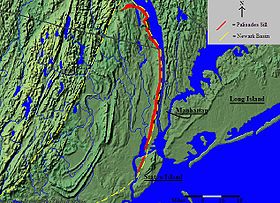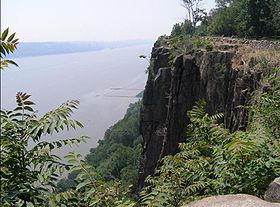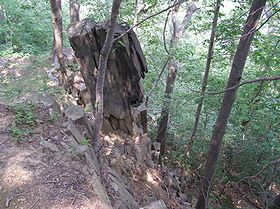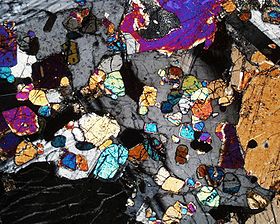
Palisades Sill
Encyclopedia

Triassic
The Triassic is a geologic period and system that extends from about 250 to 200 Mya . As the first period of the Mesozoic Era, the Triassic follows the Permian and is followed by the Jurassic. Both the start and end of the Triassic are marked by major extinction events...
, 200 Ma diabase
Diabase
Diabase or dolerite is a mafic, holocrystalline, subvolcanic rock equivalent to volcanic basalt or plutonic gabbro. In North American usage, the term diabase refers to the fresh rock, whilst elsewhere the term dolerite is used for the fresh rock and diabase refers to altered material...
intrusion
Intrusion
An intrusion is liquid rock that forms under Earth's surface. Magma from under the surface is slowly pushed up from deep within the earth into any cracks or spaces it can find, sometimes pushing existing country rock out of the way, a process that can take millions of years. As the rock slowly...
. It extends through portions of New York
New York
New York is a state in the Northeastern region of the United States. It is the nation's third most populous state. New York is bordered by New Jersey and Pennsylvania to the south, and by Connecticut, Massachusetts and Vermont to the east...
and New Jersey
New Jersey
New Jersey is a state in the Northeastern and Middle Atlantic regions of the United States. , its population was 8,791,894. It is bordered on the north and east by the state of New York, on the southeast and south by the Atlantic Ocean, on the west by Pennsylvania and on the southwest by Delaware...
. It is most noteworthy for The Palisades
New Jersey Palisades
The Palisades, also called the New Jersey Palisades or the Hudson Palisades are a line of steep cliffs along the west side of the lower Hudson River in northeastern New Jersey and southern New York in the United States. The cliffs stretch north from Jersey City approximately 20 mi to near...
, the cliffs that rise steeply above the western bank of the Hudson River
Hudson River
The Hudson is a river that flows from north to south through eastern New York. The highest official source is at Lake Tear of the Clouds, on the slopes of Mount Marcy in the Adirondack Mountains. The river itself officially begins in Henderson Lake in Newcomb, New York...
. The ideal location and accessibility of the sill
Sill (geology)
In geology, a sill is a tabular sheet intrusion that has intruded between older layers of sedimentary rock, beds of volcanic lava or tuff, or even along the direction of foliation in metamorphic rock. The term sill is synonymous with concordant intrusive sheet...
, as well as its unique features, have generated much attention from nature enthusiasts, rock climbers, and geologists alike.
Location


Manhattan
Manhattan is the oldest and the most densely populated of the five boroughs of New York City. Located primarily on the island of Manhattan at the mouth of the Hudson River, the boundaries of the borough are identical to those of New York County, an original county of the state of New York...
. The exposure is approximately 80 kilometres (49.7 mi) long, most of it following the Hudson River
Hudson River
The Hudson is a river that flows from north to south through eastern New York. The highest official source is at Lake Tear of the Clouds, on the slopes of Mount Marcy in the Adirondack Mountains. The river itself officially begins in Henderson Lake in Newcomb, New York...
. It first emerges in Staten Island
Staten Island
Staten Island is a borough of New York City, New York, United States, located in the southwest part of the city. Staten Island is separated from New Jersey by the Arthur Kill and the Kill Van Kull, and from the rest of New York by New York Bay...
in New York City
New York City
New York is the most populous city in the United States and the center of the New York Metropolitan Area, one of the most populous metropolitan areas in the world. New York exerts a significant impact upon global commerce, finance, media, art, fashion, research, technology, education, and...
. The sill then crosses the state line into New Jersey, where Hoboken
Hoboken, New Jersey
Hoboken is a city in Hudson County, New Jersey, United States. As of the 2010 United States Census, the city's population was 50,005. The city is part of the New York metropolitan area and contains Hoboken Terminal, a major transportation hub for the region...
, Jersey City
Jersey City, New Jersey
Jersey City is the seat of Hudson County, New Jersey, United States.Part of the New York metropolitan area, Jersey City lies between the Hudson River and Upper New York Bay across from Lower Manhattan and the Hackensack River and Newark Bay...
, Union City
Union City, New Jersey
Union City is a city in Hudson County, New Jersey, United States. According to the 2010 United States Census the city had a total population of 66,455. All of the city is on land, an area of...
, Fort Lee
Fort Lee, New Jersey
Fort Lee is a borough in Bergen County, New Jersey, United States. As of the 2010 United States Census, the borough population was 35,345. Located atop the Hudson Palisades, the borough is the western terminus of the George Washington Bridge...
, and Englewood Cliffs
Englewood Cliffs, New Jersey
Englewood Cliffs is a borough in Bergen County, New Jersey, United States. As of the 2010 census, the borough population was 5,281. The borough houses the world headquarters of CNBC and the American headquarters of Unilever, and is home to both Ferrari and Maserati North America.Englewood Cliffs...
all lie on it.
The sill eventually crosses back into New York, following the Hudson River north until reaching Haverstraw
Haverstraw (village), New York
Haverstraw is a village in the town of Haverstraw in Rockland County, New York, United States located north of Congers; southeast of West Haverstraw; east of Garnerville, New York; northeast of New City and west of the Hudson River at its widest point...
. It is at this point that the sill makes a turn to the west, where it disappears near Pomona
Pomona, New York
Pomona is a village partly in the Town of Ramapo and partly in the Town of Haverstraw in Rockland County, New York, United States, located north of New Hempstead, east of Harriman State Park, north of Monsey and west of Mount Ivy. According to the 2010 Census, the population was 3,103, a 13 percent...
. At this turn, the sill cuts across local strata
Stratum
In geology and related fields, a stratum is a layer of sedimentary rock or soil with internally consistent characteristics that distinguish it from other layers...
, making it a dike
Dike (geology)
A dike or dyke in geology is a type of sheet intrusion referring to any geologic body that cuts discordantly across* planar wall rock structures, such as bedding or foliation...
in that area, not a sill.
It has been proposed that the sill reemerges in two locations in Pennsylvania (where the outcrops are also discordant with local strata), but this idea is not generally agreed upon, and discussion of the Palisades Sill is usually limited to the exposure in New York and New Jersey.
A portion of the sill is also home to the Palisades Interstate Parkway
Palisades Interstate Parkway
The Palisades Interstate Parkway is a long limited-access highway in the U.S. states of New Jersey and New York. The parkway is a major commuter route into New York City from Rockland and Orange counties in New York and Bergen County in New Jersey...
, a stretch of road that passes through the park area preserved by John D. Rockefeller
John D. Rockefeller
John Davison Rockefeller was an American oil industrialist, investor, and philanthropist. He was the founder of the Standard Oil Company, which dominated the oil industry and was the first great U.S. business trust. Rockefeller revolutionized the petroleum industry and defined the structure of...
to protect its natural beauty.
Geology


Pangaea
Pangaea, Pangæa, or Pangea is hypothesized as a supercontinent that existed during the Paleozoic and Mesozoic eras about 250 million years ago, before the component continents were separated into their current configuration....
. What is now eastern North America began to separate from what is now north-western Africa, creating the young Atlantic Ocean
Atlantic Ocean
The Atlantic Ocean is the second-largest of the world's oceanic divisions. With a total area of about , it covers approximately 20% of the Earth's surface and about 26% of its water surface area...
. Magma was generated through decompression melting, and a portion of it was intruded into the sandstones and arkose
Arkose
Arkose is a detrital sedimentary rock, specifically a type of sandstone containing at least 25% feldspar. Arkosic sand is sand that is similarly rich in feldspar, and thus the potential precursor of arkose....
s of the Stockton Formation
Stockton Formation
The Triassic Stockton Formation is a mapped bedrock unit in Pennsylvania, New Jersey, and New York. It is named after Stockton, New Jersey, where it was first described...
within the Newark Basin
Newark Basin
The Newark Basin is a sediment-filled rift basin located mainly in northern New Jersey but also stretching into south-eastern Pennsylvania and southern New York. It is part of the system of Eastern North America Rift Basins.-Geology:...
, one of the Eastern North America Rift Basins
Eastern North America Rift Basins
The Eastern North America Rift Basins are a series of sediment-filled depressions created by large-scale continental extension. Their positions closely mirror the eastern coast of North America.-Geology:...
. The magma would eventually solidify and, after millions of years, the overlying rocks would be uplifted and eroded, exposing the Palisades Sill as we know it today.
The composition of the sill is that of diabase
Diabase
Diabase or dolerite is a mafic, holocrystalline, subvolcanic rock equivalent to volcanic basalt or plutonic gabbro. In North American usage, the term diabase refers to the fresh rock, whilst elsewhere the term dolerite is used for the fresh rock and diabase refers to altered material...
, although its mineral
Mineral
A mineral is a naturally occurring solid chemical substance formed through biogeochemical processes, having characteristic chemical composition, highly ordered atomic structure, and specific physical properties. By comparison, a rock is an aggregate of minerals and/or mineraloids and does not...
assemblage is not uniform throughout the thickness of the body. The mineralogy of the sill consists principally of plagioclase
Plagioclase
Plagioclase is an important series of tectosilicate minerals within the feldspar family. Rather than referring to a particular mineral with a specific chemical composition, plagioclase is a solid solution series, more properly known as the plagioclase feldspar series...
feldspar
Feldspar
Feldspars are a group of rock-forming tectosilicate minerals which make up as much as 60% of the Earth's crust....
, several varieties of pyroxenes, and olivine
Olivine
The mineral olivine is a magnesium iron silicate with the formula 2SiO4. It is a common mineral in the Earth's subsurface but weathers quickly on the surface....
, with minor biotite
Biotite
Biotite is a common phyllosilicate mineral within the mica group, with the approximate chemical formula . More generally, it refers to the dark mica series, primarily a solid-solution series between the iron-endmember annite, and the magnesium-endmember phlogopite; more aluminous endmembers...
, titanite
Titanite
Titanite, or sphene , is a calcium titanium nesosilicate mineral, CaTiSiO5. Trace impurities of iron and aluminium are typically present...
, zircon
Zircon
Zircon is a mineral belonging to the group of nesosilicates. Its chemical name is zirconium silicate and its corresponding chemical formula is ZrSiO4. A common empirical formula showing some of the range of substitution in zircon is 1–x4x–y...
and oxides.
Most researchers report that, generally speaking, the sill becomes progressively differentiated
Igneous differentiation
In geology, igneous differentiation is an umbrella term for the various processes by which magmas undergo bulk chemical change during the partial melting process, cooling, emplacement or eruption.-Primary melts:...
as one moves away from either the upper or lower contact. The "sandwich horizon" is the term given to the central region where both cooling fronts met; it is here where the diabase
Diabase
Diabase or dolerite is a mafic, holocrystalline, subvolcanic rock equivalent to volcanic basalt or plutonic gabbro. In North American usage, the term diabase refers to the fresh rock, whilst elsewhere the term dolerite is used for the fresh rock and diabase refers to altered material...
is the most differentiated.
The most intriguing geological feature of the sill is a 10-meter-thick olivine
Olivine
The mineral olivine is a magnesium iron silicate with the formula 2SiO4. It is a common mineral in the Earth's subsurface but weathers quickly on the surface....
-rich zone roughly 10 meters (30 ft) from the lower contact. The modal percent of olivine goes from 0-2% within the main body of the sill to up to 28% within this layer. It is the origin of this layer, and subsequently, the sill as a whole, that has generated much of the attention, as well as the varying origin theories proposed for the intrusion (see below).
There is an average stratigraphic thickness of 300 meters (~1000 feet), with the famous cliffs rising 100 meters (300 ft) on average above sea level. The intrusion dips
Strike and dip
Strike and dip refer to the orientation or attitude of a geologic feature. The strike line of a bed, fault, or other planar feature is a line representing the intersection of that feature with a horizontal plane. On a geologic map, this is represented with a short straight line segment oriented...
between 10 and 15 degrees westward for most of its length. It has been determined through stratigraphic studies that the sill was intruded at a depth of approximately 3-5 kilometers. These studies also concluded that the sill was emplaced in a position nearly identical to its current one (10-to-15-degree dip); this is further confirmed by the still-vertical orientation of the columnar jointing.
It has been proposed that the Watchung basalt
Basalt
Basalt is a common extrusive volcanic rock. It is usually grey to black and fine-grained due to rapid cooling of lava at the surface of a planet. It may be porphyritic containing larger crystals in a fine matrix, or vesicular, or frothy scoria. Unweathered basalt is black or grey...
flows of the Watchung Mountains
Watchung Mountains
The Watchung Mountains are a group of three long low ridges of volcanic origin, between 400 ft. and 500 ft. high, lying parallel to each other in northern New Jersey in the United States...
are extrusive eruptions of the same magma that created the Palisades Sill. Magnetic and gravity measurements have indicated the presence of a large subsurface dike between the Palisades intrusion and the Ladentown basalt, an extrusive body of Watchung basalt north of Suffern, New York. More recently, the various Watchung flows have been correlated to geochemically distinct layers within the Palisades sill, bolstering the theory that eruptions of the Palisades magma were responsible for the episodic flood basalts of the Newark Basin
Newark Basin
The Newark Basin is a sediment-filled rift basin located mainly in northern New Jersey but also stretching into south-eastern Pennsylvania and southern New York. It is part of the system of Eastern North America Rift Basins.-Geology:...
.
Origin

- The original studies concluded that the sill was the result of a single injection of magma. The variety in mineralogy was credited to simple crystal fractionationFractionationSee also: Fractionated spacecraftFractionation is a separation process in which a certain quantity of a mixture is divided up in a number of smaller quantities in which the composition changes according to a gradient. Fractions are collected based on differences in a specific property of the...
.
- The next model introduced whole rock geochemistryGeochemistryThe field of geochemistry involves study of the chemical composition of the Earth and other planets, chemical processes and reactions that govern the composition of rocks, water, and soils, and the cycles of matter and energy that transport the Earth's chemical components in time and space, and...
data and determined that there were at least two separate injections; an olivine-rich magma was followed by normal tholeiitic basalt.
- The third hypothesis instead proposed at least three, but probably four separate pulses, with the olivine-rich magma being the final one. This was also conjectured through the use of whole-rock chemistry.
Each of these theories supported the idea of crystal fractionation playing a significant, if not total, role in the differentiation of the sill. A single source for the magma was assumed.
- The latest conclusion reached for the origin of the intrusion was that the olivine in the olivine-rich zone could not have been in equilibrium with the rest of the body, indicating more than one source for the magma. This was determined through mass balanceMass balanceA mass balance is an application of conservation of mass to the analysis of physical systems. By accounting for material entering and leaving a system, mass flows can be identified which might have been unknown, or difficult to measure without this technique...
equations. It was also suggested that lateral flow within the still-liquid body played as important a role in differentiation as fractionation.
Due to the interest in the subject, and a lack of a satisfactory conclusion, research on the Palisades Sill is currently ongoing.

